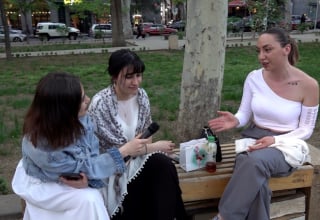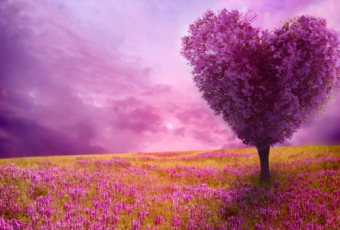Armenian Artists Contemplate Notions of Home and Belonging
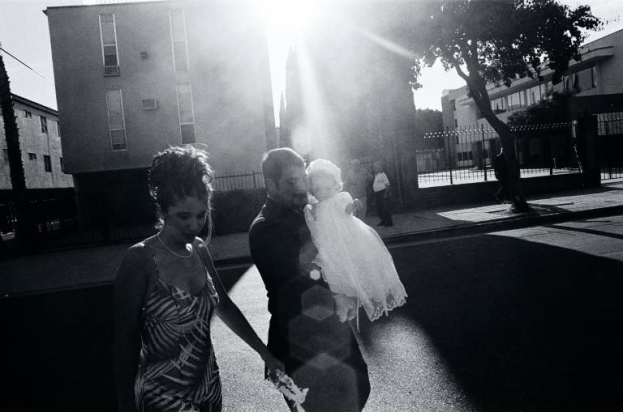
Some mountains are places and some are symbols. Mt. Ararat is both, a national and cultural symbol of Armenia and popularly considered the Biblical resting place of Noah’s Ark, Hyperallergic writes. According to the website, that is why it’s striking to see mounds of earth from the mountain — little piles of soil, obsidian tools, and even animal remains — in a gallery alongside “The Light Under Dark Clouds,” a myth-making image of Ararat by photographer Sossi Madzounian that shows the mountain cast under dark and light clouds. These mounds of earth come from an 8,000-year-old farming community at Ararat, reminding us that it’s a place and a symbol, an ancient home since the dawn of agriculture.
The mounds, and Madzounian’s photo, meet visitors at the entry to Remain in Light: Visions of Homeland and Diaspora, an exhibition of Armenian photographers currently on view at UCLA’s Fowler Museum. Alongside Madzounian are photographers Ara Mgrdichian and Ara Oshagan, all diaspora-born Armenian artists who live in Los Angeles, a city and county that is home to the second-largest Armenian population in the world outside Armenia itself.
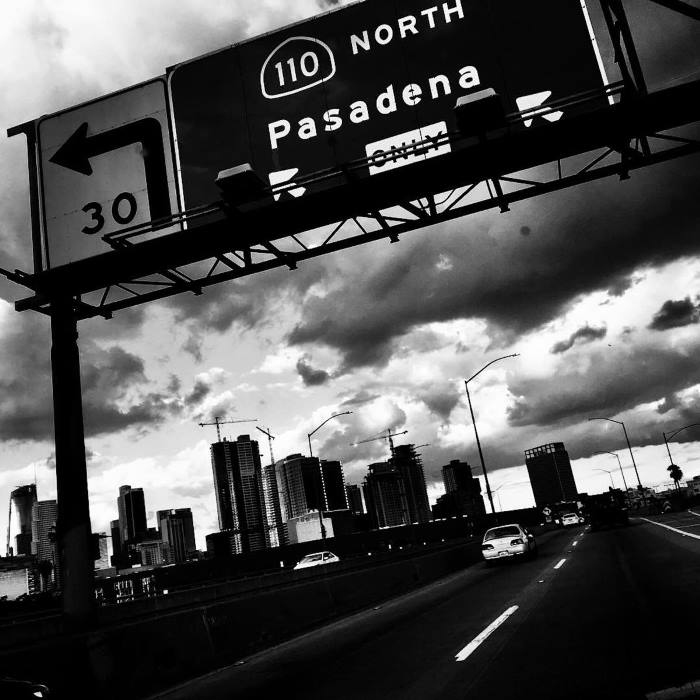
“Quo Vadis?” by Mgrdichian, a photo of signs pointing to LA’s “sister cities,” highlights the importance of Los Angeles as a diasporic home. A small sign points to the right to indicate the direction of Yerevan, Armenia’s capital, 7200 miles (~11,500 km) away. Next to this work is “Hand in Hand,” a photograph of children from the Orran Center for socially vulnerable children and families in Yerevan. They hold pieces of paper with their handprints on them.
Much of the show jumps back and forth between Los Angeles and Armenia, underscoring the blurriness of living in diaspora. Part of what makes the exhibition successful is curator Gassia Armenian’s arrangements, which draw connections between themes and regions. In “Mother and Child,” Madzounian depicts the christening of a first-born son in Armenia’s Vayots Dzor Province. The photo is composed to look like a Virgin Mother and child, an important religious symbol in many Armenian churches.
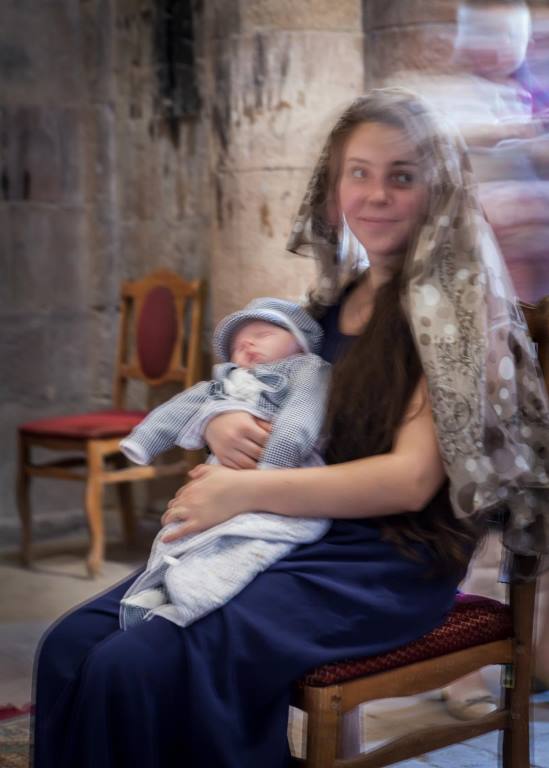
A few walls down, Mgrdichian’s “Mgrdoutioune” depicts a baptism in Glendale, the heart of the Armenian diaspora in Los Angeles County, where a man, presumably a father, holds a crying child. In the nearby “Christening,” Ara Oshagan shows Der Hovaness, a priest at Gantzasar monastery in Vank Village, Armenia, administering a blessing. Like pictures traded on a family WhatsApp chat, the photos speak to each other across time and space, suggesting the glue that religion and ritual play for cultures in diaspora.
Other important connections include photos addressing the 1915 Armenian genocide — in Oshagan’s “April 24” (the date commemorating the genocide victims), a man wearing a t-shirt saying “Genocide Never Again” appears to be crying on the street, while in Mgrdichian’s “Fight the Power,” people march in solidarity as they wave the US and Armenian flags. “Lachin,” a photo Oshagan took in Artsakh, shows a young boy on wooden stairs in the Lachin corridor of Artsakh, which connects the region to Armenia. Azerbaijan launched an attack on the region in 2020 and, as of press time, over 100,000 ethnic Armenians have fled the area following a military offensive from Azerbaijan that started on September 19.
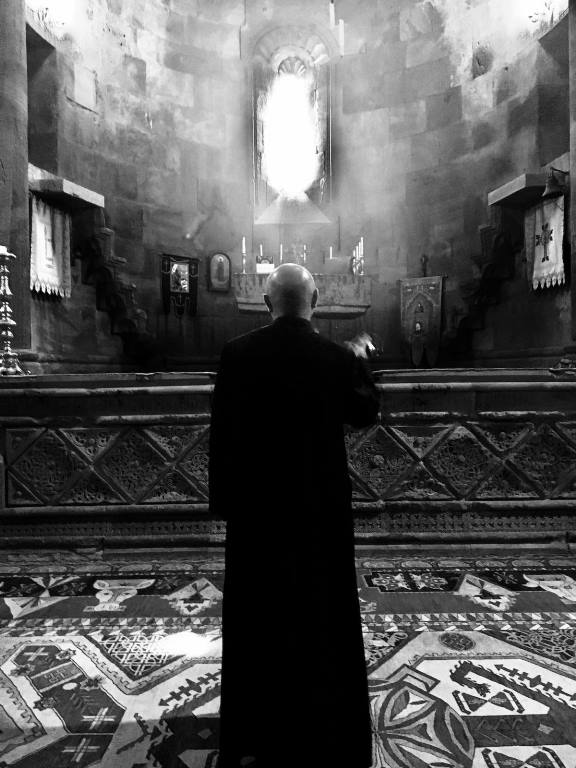
Gassia Armenian’s decision to include the artists’ own words brings to life their stories, making them as much a part of the show as the people and landmarks they photograph. Oshagan offers his identity as “a neural network made up of American/Armenian/Arabic/French parts that are in constant flux, in harmony and contention.” It’s a useful way to describe the exhibition — like Ararat, the photos speak to home as both a place and a symbol. In the face of diaspora and resistance, dispossession and defiance, home is always in flux.
Remain in Light: Visions of Homeland and Diaspora continues at the Fowler Museum at UCLA (308 Charles E. Young Drive North, Westwood, Los Angeles) through October 15. The show was curated by Gassia Armenian, Fowler curatorial and research associate.
Follow NEWS.am STYLE on Facebook, Twitter and Instagram
- My great grandparents were victims of this terrible genocide: Kev Orkian In a memory of the victims of the Armenian Genocide of 1915, Kev Orkian has made a post on Instagram, telling his ancecstors were also killed because of that terrible crime by Ottoman Empire...
- Vahe Berberian published the only photo of his grandfather, a victim of the Armenian Genocide, and talked about his promise Actor, comedian and writer Vahe Berberian has published on Instagram an archival photo of his grandfather who was a victim of the Armenian Genocide, noting that it is the only memory he has of him...
- Today we commemorate the 1.5 million Armenians that died in 1915. Those who lost their lives included my great great grandmothers and grandfathers: Diana Madison In the memory of the 109th anniversary of the Armenian Genocide, American Armenian actress, producer Diana Madison has published a video on Instagram, presenting the story of her ancestors, stressing the importance of not forgetting and condemning the Armenian Genocide...
- I want to remember my ancestors who perished and those who survived: Serj Tankian commemorates the victims of the Armenian Genocide of 1915 American-Armenian musician, member of System of a Down, Serj Tankian commemorated the victims of the 1915 Armenian Genocide...
- This tragedy was an integral part of his life։ Kristina Aznavour shares some archived photos of Charles Aznavour and George Clooney taken in Tsitsernakaberd Charles Aznavour's daughter-in-law, Kristina Aznavour, has published some archived photos on Instagram...
-
21:11, May 8
World’s ex-richest man, Warren Buffett: Success isn't about money, it's about being loved by those you want to love -
20:26, May 8
Sylvester Stallone's watches, including ‘Holy Grail’ of his collection, to be auctioned -
19:27, May 8
New York's Times Square tops list of world’s worst tourist traps -
16:32, May 8
Horror movie to be made about Jesus’ childhood -
15:11, May 8
Khloe Kardashian speaks about problems she faced after birth of her son, Tatum -
15:00, May 8
Eurovision 2024: Alexander Rybak says Armenian song Jako is one of his favorites -
14:18, May 8
Anna Wintour bans 3 foods from Met Gala -
13:21, May 8
Eurovision 2024: How to vote for Armenia? -
13:17, May 8
‘Wednesday’ 2nd season shooting kicks off -
12:34, May 8
Jessica Biel takes bath with 9kg of salt before Met Gala -
11:23, May 8
Kim Kardashian reveals secrets behind her sensational Met Gala look -
10:46, May 8
Shakira wears bold satin white dress to Met Gala after-party
All materials
- Archive





